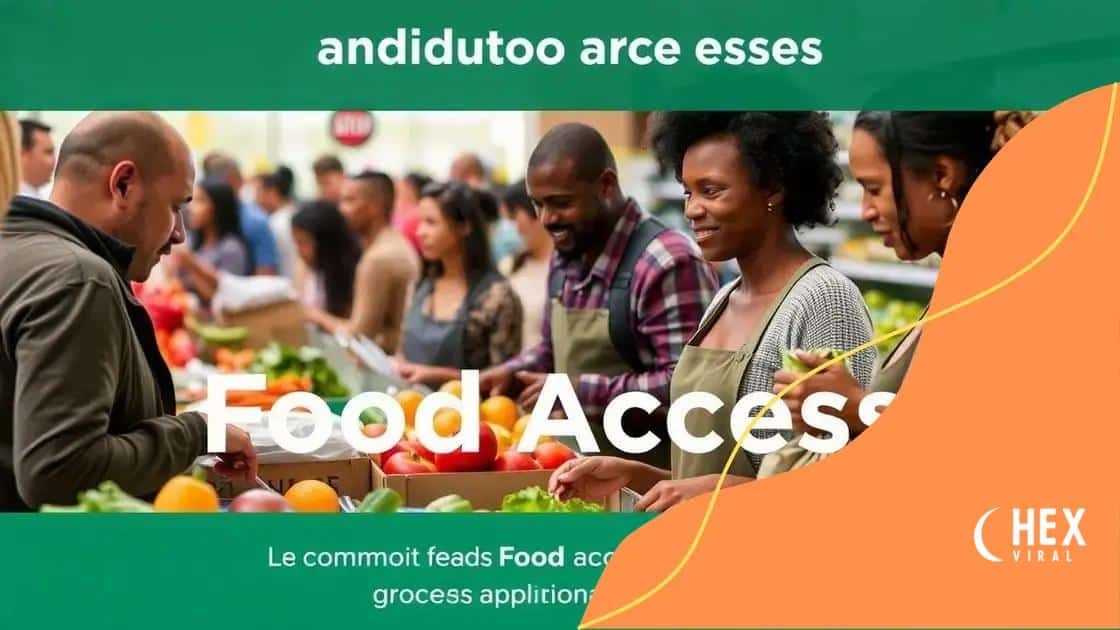Supplemental Nutrition Program (SNAP) expansions could change food access

Supplemental Nutrition Program (SNAP) expansions aim to enhance food access for families by increasing benefits, improving eligibility, and addressing food insecurity in communities across the United States.
Supplemental Nutrition Program (SNAP) expansions aim to provide increased food access for families facing hardships. But how exactly do these expansions impact daily life and food security?
What are SNAP expansions?
SNAP expansions refer to changes made to the Supplemental Nutrition Assistance Program, aimed at increasing access to food benefits for eligible families. Understanding these expansions is crucial for individuals and communities that depend on this vital support.
Key Features of SNAP Expansions
Recent expansions focus on improving food security through enhanced benefits and broader eligibility criteria. Here are some key features:
- Increased monthly benefits to better meet the needs of families.
- Introduction of emergency allotments during crises.
- Expanded eligibility for certain groups, including college students.
- Flexibility in using SNAP benefits for online grocery shopping.
The aim is to reduce hunger and provide stable nutrition for low-income households. These changes also target addressing inequalities that exist in food access. By making SNAP more adaptable, the program helps families navigate difficult times.
Impact on Families
The expansions have the potential to significantly improve the lives of many. They help ensure that families have enough food, which contributes to better health and well-being. Access to nutritious food is linked to enhanced educational outcomes for children and better overall productivity.
Moreover, the expansions can aid local economies. When families receive additional benefits, they can spend more in their communities, supporting local businesses and farms. This economic ripple effect emphasizes the broader value of SNAP expansions.
Overall, SNAP expansions represent a crucial step in enhancing food access and security. They are designed not just to assist families in need but to create a more inclusive and resilient food system.
Current statistics on SNAP participation
Current statistics on SNAP participation reveal important trends regarding food assistance in the United States. Understanding these numbers helps illustrate how many families rely on this program for support.
Participation Rates
As of the latest reports, over 40 million individuals participate in the Supplemental Nutrition Assistance Program. This number represents about 12% of the U.S. population. The prevalence of SNAP participation is particularly high among children, with nearly half of all participants being under the age of 18.
- About 73% of families receiving SNAP benefits have children.
- In recent years, participation increased during economic downturns and global crises.
- SNAP beneficiaries are often employed but may work in low-wage jobs.
- Many states have seen significant increases in enrollment due to SNAP expansions.
The statistics indicate disparities in participation based on factors like income, family size, and geographical location. For instance, rural areas often see higher participation rates compared to urban spots. These trends point to the ongoing need for food assistance in various communities.
Demographic Insights
Looking at demographic insights provides further understanding of who benefits from SNAP. The program serves a diverse group of people, including:
- Low-income families, often with single parents.
- Older adults who may be living on fixed incomes.
- Individuals with disabilities facing employment challenges.
- Students balancing education and part-time work.
This wide range of participants highlights the significance of SNAP in combating food insecurity. Data also shows that most participants experience food insecurity, relying on SNAP to help bridge the gap in daily nutrition.
Benefits of SNAP expansions for families

The benefits of SNAP expansions for families are significant and far-reaching. These changes are designed to improve the nutritional intake of households facing economic challenges, ensuring that they have adequate access to food.
Enhanced Food Security
One of the primary benefits of SNAP expansions is the heightened food security they provide. Families can rely on increased monthly benefits to purchase healthy foods. This consistency is vital for maintaining a balanced diet.
- Higher benefits help in offsetting rising food costs.
- Families can access a wider variety of nutritious options.
- Food security leads to better overall health and well-being.
- Children’s academic performance improves with proper nutrition.
By ensuring families can afford the food they need, SNAP expansions contribute to better health outcomes and can reduce health risks associated with poor nutrition.
Support for Local Economies
When families use their SNAP benefits, they not only improve their own lives but also support local economies. Increased spending at grocery stores and markets helps local businesses thrive. This economic activity creates jobs and encourages investment in community services.
Moreover, long-term improvements in family nutrition can lead to fewer healthcare costs. Healthy families often experience fewer chronic health issues, which means lower expenses for public health systems.
Reduction of Stigma
SNAP expansions also help in reducing the stigma associated with receiving food assistance. As more people depend on these benefits, the perception of SNAP changes within society. Families feel more comfortable seeking help when they know that others in their community do as well.
This increasing acceptance fosters a supportive community environment, making it easier for families to access the resources they need to thrive.
Challenges in implementing SNAP expansions
Implementing SNAP expansions comes with various challenges that can affect their efficacy and reach. Understanding these hurdles is crucial to improving the program and ensuring it meets the needs of families.
Budget Constraints
One of the primary challenges is the budget required to fund expansions. Governments face tight budgets, and increasing SNAP benefits can be financially daunting. Allocating funds for food assistance competes with other vital services like education and healthcare.
- States must balance SNAP benefits with overall budget priorities.
- In times of economic downturn, funding may be cut.
- Addressing the needs of other programs can limit SNAP expansions.
These financial considerations often lead to debates on how best to provide support, making it harder to implement broader changes swiftly.
Bureaucratic Processes
The bureaucracy involved in government programs can slow down the implementation of expansions. Changes often require extensive planning, approval, and coordination among different agencies and departments.
Administrative burdens can lead to delays and inefficiencies. Streamlining processes is often necessary but challenging.
Public Awareness and Education
Even with expansions in place, families need to know how to access and utilize benefits. Many eligible individuals may not be aware of their options or how to apply for assistance.
- Outreach programs are essential but often lack sufficient funding.
- Educational efforts about SNAP expansions must effectively reach target communities.
- Language barriers and misinformation can hinder access.
- Community engagement is vital for spreading awareness.
Ensuring that families understand the benefits available to them is a critical step. Without proper education and outreach, even the best expansions may fall short of their potential impact.
Future of SNAP and food access initiatives
The future of SNAP and food access initiatives looks promising yet challenging. Increasing awareness of food insecurity has sparked discussions on how to enhance programs like SNAP.
Innovative Approaches
Future initiatives may focus on implementing more innovative solutions. These could include technology-driven platforms to streamline applications and enhance access to benefits.
- Mobile apps could help recipients track their benefits and find local stores.
- Partnerships with grocery delivery services may increase accessibility for those without transportation.
- Online education tools could provide valuable resources for better nutrition planning.
By leveraging technology, SNAP can evolve to meet the changing needs of families more effectively.
Policy Changes
Advocates also push for policy changes that could reform SNAP. These changes may include expanding eligibility and increasing benefits to match rising living costs. Discussions on eliminating stigma and promoting acceptance are equally crucial for the program’s success.
Future policies might emphasize nutrition education as a core component. Offering workshops or classes could empower families to make healthier choices with their benefits.
Community Engagement
Community involvement is essential for the future of food access initiatives. Programs that engage local organizations can tailor solutions to meet specific community needs. This collaboration can improve outreach and education efforts.
- Building partnerships with local food banks and community gardens can enhance food accessibility.
- Hosting events to raise awareness about SNAP can destigmatize food assistance.
- Engaging with families to gather feedback can help refine programs.
- Informing families about their rights and resources can empower them to seek assistance confidently.
Enhancing community connections ensures that SNAP and food access initiatives remain relevant and effective in addressing hunger.
In conclusion, the future of SNAP is vital for food security in America. As we look ahead, it’s essential to focus on innovative approaches, policy changes, and strong community engagement. Addressing challenges and implementing effective solutions can help ensure that families have the support they need for a healthy and secure future. Together, we can work towards a world where every family has access to nutritious food.
FAQ – Common Questions About SNAP and Food Access
What are SNAP expansions?
SNAP expansions involve increasing benefits and eligibility to improve food access for families in need.
How do SNAP expansions benefit families?
They enhance food security, support local economies, and reduce stigma associated with receiving food assistance.
What challenges exist in implementing SNAP expansions?
Challenges include budget constraints, bureaucratic processes, and the need for public awareness about available benefits.
What is the future of food access initiatives?
The future focuses on innovative approaches, policy changes, and strong community engagement to improve support for families.






